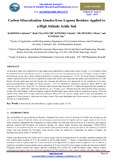Carbon Mineralization Kinetics from Legume Residues Applied to a High Altitude Acidic Soil
Date
2019-04-04Author
Salvator, KABONEKA
ONG’OR, Basil T.Iro
Chantal, KWIZERA
Menus, NKURUNZIZA
Elie, KWIZERA
Metadata
Show full item recordAbstract
An incubation study was conducted for 56 days under room temperature in a high altitude acidic soil (pH = 4.2) to evaluate carbon (C) mineralization from pea (Pisum sativum L.) residues and leaves from two agroforestry species (Calliandra calothyrsus Meisnand Gliricidia sepium (Jacq.) Walp. Carbon dioxide (CO2) evolution was measured at 7, 14, 21, 28, 42 and 56 days of incubation. Carbon mineralization was best fit to a sequential decomposition model with a rapid and slow phase, each described by first-order kinetics. Percent rapid, rapid and slow fraction rate constants and half-lives were determined. At the completion of the study, percent decomposition was higher for Pisum sativum L. (77.3 %) followed by Calliandra calothyrsus Meisn(60.8 %) and Gliricidia sepium (Jacq.) Walp(56.7 %). Similarly, higher percent rapid fractions (78 %), higher decomposition rate constants (kr = 0.053 day-1; ks = 0.012 day-1) and lower half-lives [t0.5(r) = 13 days; t0.5(s) = 58 days] were also observed with Pisum sativum L.residues. From the findings of this investigation, it appears that the higher lignin content of the two agroforestry species,Gliricidia sepium (Jacq.) Walp(6.33 %) and Calliandra calothyrsus Meisn(4.16 %) was the limiting factor of their decomposability, as compared toPisum sativum L. which had zero lignin content.This study highlighted pea (Pisum sativum L.) residue as the most effective in C mineralization
URI
https://doi.org/10.31695/IJASRE.2019.33119https://ijasre.net/index.php/ijasre/article/view/159/194
http://ir-library.mmust.ac.ke:8080/xmlui/handle/123456789/2503
Collections
- Journal Articles [411]

